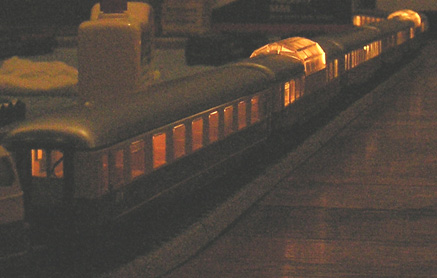
6 Fully Lit TEE Cars
Gadgets are things that let you do more than just run the trains around and around. They include Switches for sending trains from one track to another, Yards with Uncoupling Tracks for parking cars and building up trains from individual cars, Cranes for lifting and placing cargo, Smoke Stacks for making your Steam Engines produce gorgeous smoke effects, Interior Lighting to make your Passenger Trains look kewl with the lights off, and sweeping Bridges that get your Trains rising up and over each other.
[A Note About The Photography On This Page: Many of the shots and movies on this page were made with cheap digital cameras. Please forgive the lack of quality, I did my best.]

The Trans Europe Express
One benefit of having worked and lived a bit in The Netherlands however is being able to finally get the right lights for my cars. I finally got all the cars on my TEE Express (The Raffi Train) lit correctly, and its very beautiful.
The shot on the right was made with an Olympus Digital Camera in Macro mode, mounted on a tripod. Despite several attempts, its still not right, but I think you can get the idea of what a lit passenger train in a dark room looks like.
On the left is a very badly made movie of the TEE Express running in the dark. I'm putting this up for Harold Van Aalderen, who helped me get the lighting for these cars. I apologize for the small size and TV audio in the background, but it was originally just a test movie. I had to give back the Olympus before I could make the finished movie. Still, it highlights the effect, note the glare of the train reflecting off my hardwood floor.
My First Passenger Train
I destroyed the first 2 passenger cars I ever had. But then I worked and saved and bought 2 more passenger cars, and I have those until this day. Because Mom was pretty upset that I had destroyed the first 2 passenger cars, I went out of my way to light and enhance the new ones, and to make it a passenger train for the christmas tree.

And Mom bought a lighted baggage car, and we had created our own piece of model railroad beauty. Which the Cat promptly pounced upon again and again...
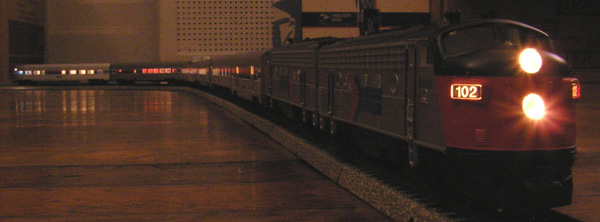
The best train I have is the AMTRAK model that Märklin made back in the late 1990s. It rides well, looks great, and has some incredible lighting.
I used the Digital Camera to capture some shots with the lights on, even though Frank had already documented it back in 1999 with the lights off. First, notice the road number plates in this long shot, and the starbursts off the headlights.
More importantly, notice the color of the lights in cars -- some are a warmer yellow to simulate incandescent lighting, and some are a brighter bluer white to simulate fluorescent lighting. Märklin not only detailed the car bodies, the engine and the paint scheme, they detailed the lighting.
Here is a shot of the back of the train in a curve that highlights the difference. Note that the last car is blueish-white, the next car is yellowish, and the observation car after it is blueish-white again.

By the way, at the time of this writing (2006) I estimate the AMTRAK Train is worth $1000 on eBay in fair trading, based upon recent auctions for the same parts in equal or worse shape. But I'm not selling. :)
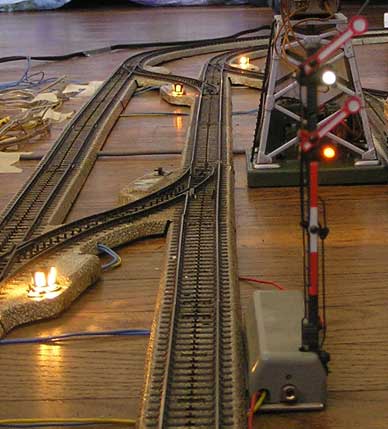
The switch lights are kind of interesting. They are small square boxes that are meant to be viewed from either the front or the back (where the Engineer driving the train would see them), and indicate the setting of the switch. From the front, they show a straight line for straight, and an arrow pointing in the direction of the curve for curved. From the back they show a thicker straight line for straight, and a circle for curved.
You use a Control Panel to change all this stuff. Each pair of Red/Green buttons controls one signal or one switch. When you press a button, you have to hold it down to make the the connection, but when you release it, it still stays low on the panel. If you wire it right, you can glance at the panel and see how everything is set. For example, the first pair is Green Down, so its open, the switch is set straight or the signal was set green/go. The remaining pairs are Green Up, so they are all set to curved or red/stopped.
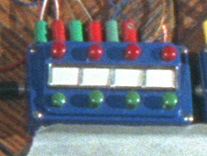
If you're doing this and you are not having fun, sell the trains and take up Crochet or Hang Gliding or something.
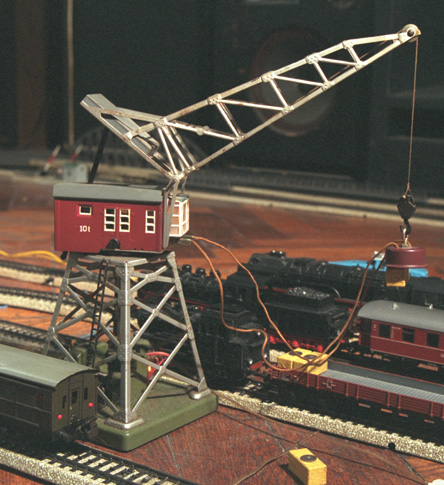
This version is from about 1975. I've cleaned the base and kept the motors working, but I'm not sure what to do about the rust.
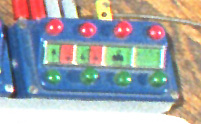
Unfortunately, this version cannot raise and lower the boom to bring the magnet closer and farther from the crane body. The black metal rod running from the bottom of the boom through the control cab is a simple saw-tooth device, so you have to set the angle of the boom by hand.
Hours of time can easily be lost removing and placing "cargo" on the cars. Even more time can be lost trying to "flip" one of those yellow bales of hay that has rolled so the thumbtack is no longer on top. You simply knock into it again and again with the edge of the magnet, trying to catch the upper edge while cursing under your breath. No hands, remember?
Even though the Crane doesn't move around on the floor, the Cat still doesn't trust it, because it makes the same noise as the Engines, and therefore must be just as evil. For anyone who's played Half-Life 2, this crane is the same kind they use to move the Dune Buggy in the Ant Lion sequences in the game, and that you get to control when you have to pick your Buggy up and put it on the wharfs above the sand.
From the New York State Govenor's Traffic Safety Committee website (2006):
Question: How often do a vehicle and train collide in the U.S.?I cannot stress this enough.
Answer: About every 90 minutes a vehicle and train collide in the U.S.
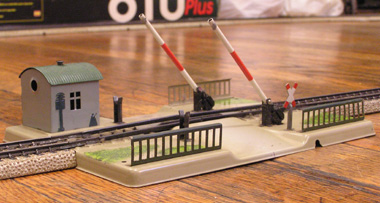
Notice how the rails are angled up in the middle of the grade. They are resting on springs, and as the train runs over them, the weight of the engine and cars pushes down the rails, which pull down the gates by a linkage under the baseplate. There's a bit of jiggling as the wheels pass over, since the rails go up and down under the passing cars. And it makes some nice clunking noises too, so all in all it had good entertainment value and is a cheap way to add something to look at to your layout.
Here's a short movie of my Tin Plate train running over the 7390. Everyone one who's been at my house for Christmas knows this experience. Oh, and note the Fat Blue Spark I'm getting off the baggage car's pickup shoe as it rides over the Guard...
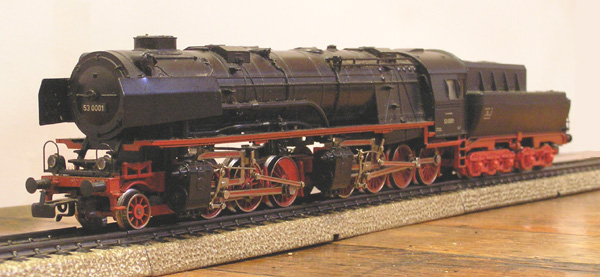
The Borsig was perhaps one the biggest German Steam locomotives that was never built. The original designs were finished in 1943, but due to the pressure of heavy Allied Bombing, it was never built. After WWII, steam declined rapidly and so the Borsig was forgotten, until Märklin decided to build one anyway, in HO scale, from the original plans.
The body of this model is made of metal. Those driving rods really work. The design is articulated, meaning that the first and second large wheel groups can turn independantly of each other so it can run on tight curves. And this model can make smoke from not 1 but 2 smoke stacks, that is actually 2 separate pipes in one housing at the front.
This is a Mallet engine, from a basic design named for Swiss engineer Anatole Mallet. This idea was first worked up in 1890, and you can read more about it on The Classic Trains Magazine website. Märklin has made newer versions recently, some with special tenders with working fans, some in a light grey paint scheme, and with digital control and sound effects. But I like my version, even if its a bit banged up. I got it off ebay back in 1999, and then got the smoke stacks on a trip to Amsterdam in 2000. It was my first experience with steam on my layout, and I loved it.
As a result, this spring I asked my friend Zicarlo Van Aalderen to get me a nice bottle of smoke oil, since I had used the last of the oil that came with the original units, and the price of replacement oil from the dealers was a bit steep. I experimented for a while with different substitutes like 3-in-1 and parafin oil, but they just weren't the same.
I'm putting this up for Zicarlo, since he didn't get a chance to see it running when he was here in May of 2006. This was originally just the test movie for the one I really wanted to make, but I had to give back the borrowed digital camera that I used.
In fact, here's the warning from the Märklin Product Listing for this lovely item:
Important Notes: This locomotive may only be operated outdoors and only by adults. The locomotive boiler may never be fired up without a sufficient supply of water in it. Dirty track caused by residues of steam and oil cannot be avoided. Depending on the load, a full boiler of water allows you to run the locomotive from about 20 to 30 minutes. Cars with regular Märklin claw couplers can be coupled to the locomotive. This model can be used in most countries in Europe.And, did I mention its Remote Controlled? There is a receiver built into the tender, and you can run it from a hand-held transmitter. So, when your beer is empty, you start her up and run her next to the table in your backyard, and put your empty on one of the freight cars. Then you run her into the kitchen on the special siding you made and blow the whistle so the hausfrau can put another Beck's on the freight car. Or a note telling you she's leaving you because you spend too much time with the trains.
Too bad I don't have a Garden up here in my Trendy NY Apartment.